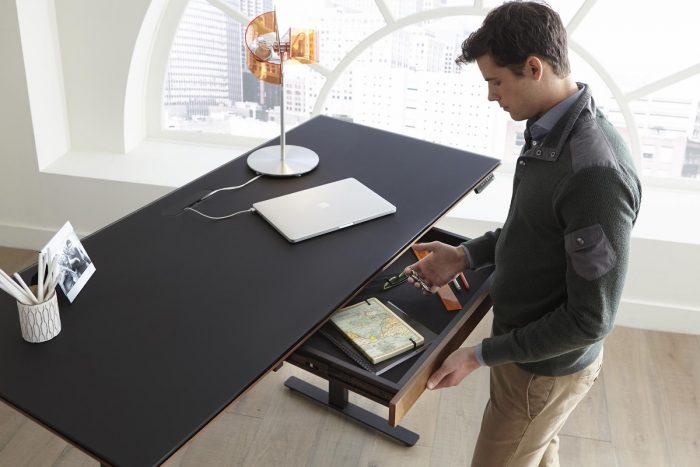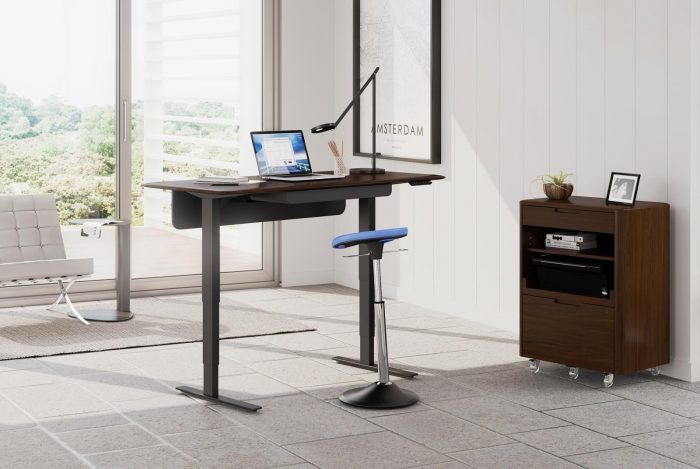BY BDI FURNITURE
Charles Dickens did it. So did Victor Hugo. Søren Kierkegaard, Virginia Wolf, Albert Einstein and Winston Churchill? You can add them to the list too.
Among their many accomplishments, these intellectual giants were all early adopters of the standing desk. It might have taken a couple hundred years or so for the rest of us to catch up, but research shows there are ample reasons for taking a stand at your workstation — regardless of whether you’re penning the next great novel, expanding on a scientific theory or leading the free world.
Here’s what you need to know about adding a sit+stand desk to your home office.
Boost your productivity
According to FlexJobs, more than 3.9 million Americans now work as least part of the time from home. In fact, with more companies offering flexibility in when and where their employees work — and with more people embarking as freelancers and independent contractors — the home office is experiencing a renaissance.
And while that long list of standing-desk cohorts certainly makes a compelling case for getting up on your feet to get things done, science makes it clear: alternating between sitting and standing boosts productivity.

Some of that is psychological. Standing is associated with action, and so when you rise from your chair you’re automatically putting yourself in a goal-oriented mindset. This means you’re focused on the task at hand and avoiding distractions like social media and instant messaging.
But there’s a physical element as well. Studies show that activities that get the blood pumping help boost brain activity and give you more energy, and even just standing can increase productivity by 10 percent. Other studies have shown a correlation between standing desks and a decrease in stress and fatigue.
Raise the bar on health
One of the biggest issues associated with sitting at a desk is the problem of prolonged sitting as a whole. Most of us spend quite a bit of time sitting. Between time spent at work, at home and commuting between the two, Americans spend an average of 9 hours sitting each day.
A sedentary lifestyle, of course, is associated with a host of health risks, and sitting for 8 hours or more each day is shown to increase risk for premature death by as much as 5 percent. Risk for developing diseases such as breast cancer, colon cancer and diabetes also is associated with prolonged sitting.
Even shorter periods of sitting can be harmful. Only an hour of sitting is associated with a 90 percent decrease in the fat-burning enzyme LPL.

However, switching between sitting and standing can do a lot to reverse these risks, which is why investing in a Sit Stand Desk is smart. Although the calorie burn is nowhere close to that of a HIIT workout or spin session, an afternoon of standing burns 170 calories more than an afternoon of sitting. Assuming a five-day workweek, that’s 3,400 calories a month, or just under a pound.
Additionally, alternating between sitting and standing can help regulate blood sugar levels, which is especially important after lunch. One study showed a reduction in blood sugar spikes by 11.1 percent.
What’s more, standing throughout the day can reduce upper back and neck pain — the well-known bane of the modern office worker — by as much as 54 percent according to a study published by the Centers for Disease Control and Prevention.
Create a work flow
Of course, moderation is the key to success in almost everything, and that includes standing. Our bodies simply aren’t designed to remain in a static standing position all day. It’s hard on the lower back, hips and knees, and it can increase risk for varicose veins and deep-vein thrombosis.

That’s why it is important to choose a model that allows you to easily switch between sitting and standing. Electronically powered, height-adjustable desks with programmable keypads make it easy to raise and lower your desk to just the right height with just the press of a button. BDI’s Sola Lift Standing Desk offers maximum functionality with sleek, contemporary styling. For best results, pair it with a well-made ergonomic office chair.
Those new to using sit-to-stand desks might want to ease into the routine. Some experts advise standing for only 30 minutes to an hour each day and gradually increasing.
And while devices like the Fitbit and Apple Watch can do a good job reminding you to stand up every hour on the hour, applying a similarly regimented approach to your sit-to-stand intervals might not work. Instead, of even splits between the two positions, consider the projects in your planner and strategize how best to get them done.
Those tasks that require intense concentration might be best completed while sitting. Lighter work such as making phone calls, dashing out emails and skimming reading materials can be done while standing.
Don’t compromise on style
Let’s be real: Many standing desks look downright industrial. That might be fine in a big corporate setting, but style is especially important when the office is a home office. Avoid the clunky metal models and look for something that blends with your existing décor.

Beautiful hardwoods are always a great choice. Features like cable-management systems and storage drawers keep your work space organized and clutter free, and durable work surfaces mean your furniture will look great for years to come.
So if you’re ready to take your work to the next level, elevate your workday with a standing desk!
Find a Home-Based Business to Start-Up >>> Hundreds of Business Listings.

















































